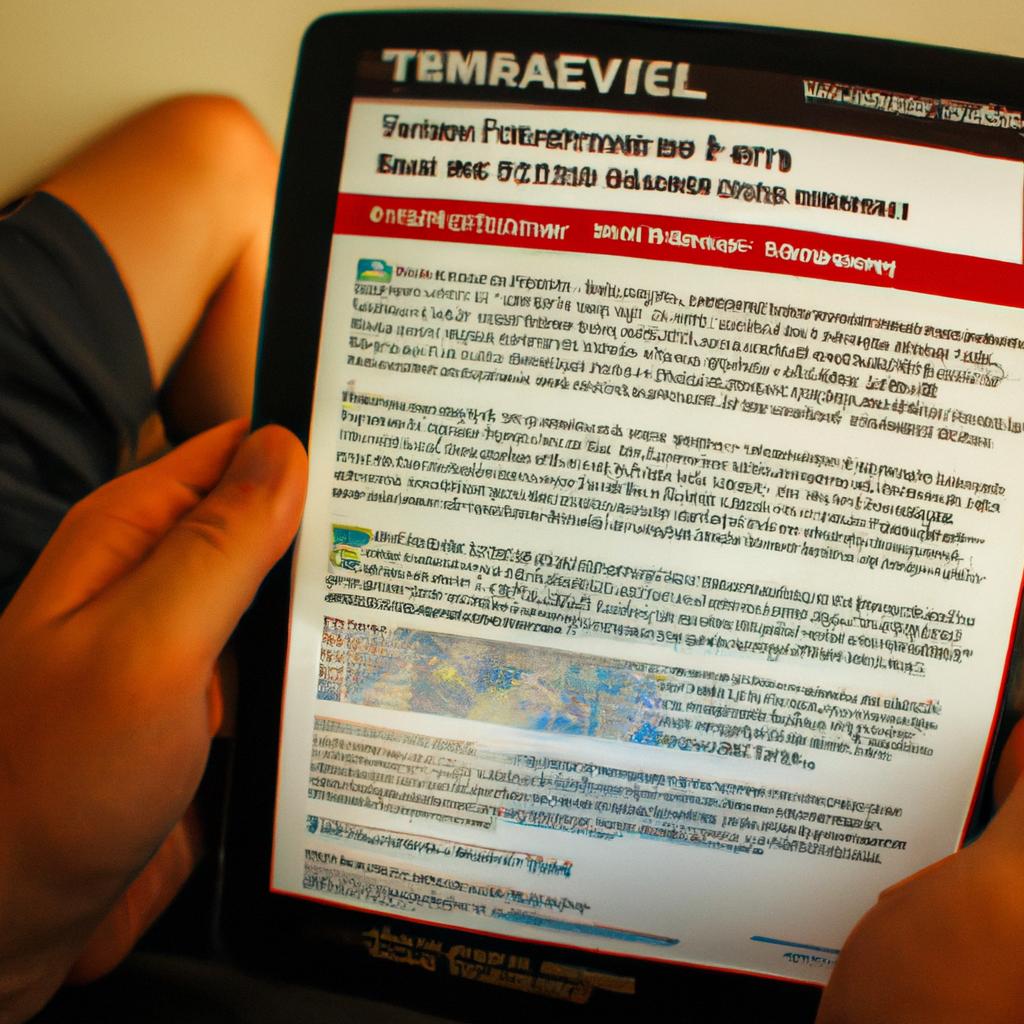Adventure travel has become increasingly popular among individuals seeking unique and exhilarating experiences. However, with the allure of venturing into unexplored territories comes the need for caution and careful planning. Travel advisories play a crucial role in ensuring the safety and well-being of adventure travelers by providing timely information about potential risks and hazards associated with particular destinations. For instance, imagine an avid hiker embarking on a solo trek through remote mountain ranges without being aware of recent reports warning of unstable weather conditions or increased wildlife activity. Ignorance of such vital information may not only compromise their personal safety but also hinder emergency response efforts in case of unforeseen events.
In this article, we will explore the significance of travel advisories within the context of adventure travel. We will delve into how these advisories are formulated, disseminated, and utilized as tools to mitigate potential risks faced by adventurous explorers. By examining real-life examples and hypothetical scenarios, we aim to highlight the importance of staying informed and making informed decisions when engaging in adventure travel activities. The objective is to provide readers with a comprehensive understanding of how travel advisories can enhance safety measures while enabling them to pursue their passion for exploration responsibly.
Why Adventure Travel is Exciting and Popular
Adventure travel offers a unique and exhilarating experience for those seeking excitement and exploration. Whether it involves trekking through rugged terrains, engaging in thrilling water sports, or discovering remote cultures, adventure travel provides individuals with the opportunity to step out of their comfort zones and embrace new challenges.
For instance, imagine embarking on a hiking expedition through the dense rainforests of Costa Rica. The adrenaline rushes as you navigate treacherous trails, encountering exotic wildlife along the way. This real-life scenario demonstrates how adventure travel can push boundaries and ignite a sense of thrill that conventional tourism often lacks.
There are several reasons why adventure travel continues to gain popularity among travelers:
- It fosters personal growth: Engaging in adventurous activities requires individuals to overcome fears and test their limits. By conquering these challenges, adventurers develop resilience, self-confidence, and a greater appreciation for their own capabilities.
- It promotes connection with nature: Adventure travel often takes place in breathtaking natural landscapes such as mountains, deserts, or oceans. These environments allow travelers to immerse themselves in the beauty of nature while fostering a deep sense of awe and respect for the planet.
- It encourages cultural exchange: Many adventure travel experiences involve interaction with local communities who have preserved traditional ways of life. Such encounters provide invaluable opportunities for cross-cultural learning and understanding.
- It creates lasting memories: The combination of unique experiences, stunning scenery, and shared moments with fellow adventurers make adventure trips memorable for a lifetime.
To illustrate further the variety of adventures available worldwide, consider the following table showcasing four popular types of adventure travel destinations:
| Destination | Activity | Duration | Difficulty Level |
|---|---|---|---|
| Patagonia | Hiking | 10 days | Moderate |
| Great Barrier Reef | Scuba diving | 5 days | Advanced |
| African Safari | Wildlife safari | 12 days | Easy to moderate |
| Himalayas | Mountaineering | 15 days | Challenging |
In conclusion, adventure travel offers a thrilling and popular alternative to traditional tourism. It appeals to those seeking personal growth, connection with nature, cultural exchange, and memorable experiences. In the following section, we will explore how travelers can stay safe and informed when embarking on adventurous journeys.
Transitioning into the subsequent section about “How to Stay Safe and Informed When Traveling,” it is essential for adventurers to be well-prepared before setting off on their travels.
How to Stay Safe and Informed When Traveling
Adventure travel can be an exhilarating experience, providing individuals with the opportunity to explore new destinations and engage in thrilling activities. However, it is essential for travelers to stay informed about potential risks and hazards associated with their chosen adventure destinations. By being aware of travel advisories issued by authorities, adventurers can make well-informed decisions that prioritize their safety.
To illustrate the importance of staying informed, let us consider a hypothetical scenario: A group of hikers plans to embark on a trek through remote mountains in a foreign country. Unbeknownst to them, recent heavy rainfall has caused landslides along the trail they intend to follow. Without access to information regarding this hazardous condition, the hikers may unknowingly put themselves at great risk.
Travel advisories serve as crucial tools for travelers seeking up-to-date information about potentially dangerous situations or regions. These advisories are typically issued by government agencies or international organizations responsible for monitoring global events and assessing security conditions worldwide. They aim to provide objective assessments and recommendations regarding health, safety, security threats, natural disasters, political instability, and other relevant concerns.
It is important for adventure enthusiasts to regularly consult travel advisories before embarking on trips. Here are some key reasons why:
- Risk assessment: Travel advisories help individuals evaluate the level of risk associated with specific destinations or activities.
- Precautionary measures: They offer valuable advice on necessary precautions to take while traveling.
- Emergency response guidance: In case unexpected circumstances arise during an adventure trip, these advisories often provide instructions on how to respond effectively.
- Health-related information: Advisories may contain updates on disease outbreaks or required vaccinations for certain areas.
In addition to written reports and guidelines provided in travel advisories, some organizations also use visual aids such as tables to present critical information more comprehensively. The table below demonstrates an example format commonly found in travel advisory resources:
| Destination | Security Status | Health Concerns | Natural Hazards |
|---|---|---|---|
| Country A | Exercise caution | Low | Moderate |
| Country B | High risk | Medium | High |
| Country C | Extreme risk | High | Extreme |
By referring to such tables, adventurers can quickly assess the overall safety conditions of potential destinations based on different categories. This facilitates informed decision-making and helps individuals plan their adventure travels more effectively.
In conclusion, staying updated with travel advisories is vital for adventure travelers as it enables them to make well-informed decisions regarding their safety. By consulting these resources regularly, individuals can evaluate risks, take necessary precautions, and respond appropriately in case of emergencies. In the subsequent section, we will explore important factors that should be considered before embarking on an adventure travel journey, ensuring a memorable yet safe experience.
Important Factors to Consider Before Embarking on an Adventure Travel
Adventure Travel: Travel Advisories
Let’s consider an example to illuminate this concept further. Imagine you are planning a hiking trip in a remote mountainous region. Without access to reliable information about potential hazards or safety concerns, your journey could take an unexpected turn for the worse.
To avoid such situations, here are some key factors regarding travel advisories that every adventure traveler should keep in mind:
- Significance: Travel advisories provide up-to-date information on security conditions, health risks, natural disasters, political stability, and other crucial aspects of travel destinations.
- Sources: These advisories are typically issued by government agencies, such as foreign affairs departments or embassies, which gather data from various sources including local authorities and intelligence reports.
- Levels: Most travel advisories use color-coded systems or numerical scales to categorize potential risks associated with specific regions or countries. It is vital to pay attention not only to the overall level but also to any specific details mentioned within the advisory.
- Responsibility: While governments issue these advisories as a means of providing guidance and protection for their citizens abroad, it remains the responsibility of individual travelers to make informed decisions based on their own risk tolerance and personal circumstances.
Consider the following table summarizing different levels of travel advisories:
| Level | Description |
|---|---|
| 1 | Exercise normal precautions |
| 2 | Exercise increased caution |
| 3 | Reconsider travel |
| 4 | Do not travel |
In conclusion, being aware of current travel advisories can help adventure travelers assess potential risks more effectively. By understanding their significance, consulting reliable sources, paying attention to levels indicated in these advisories, and taking personal responsibility, travelers can make informed decisions that contribute to a safer and more enjoyable experience.
Transitioning into the next section on top destinations for adventure travel enthusiasts, it is crucial to consider not only safety but also the allure of thrilling experiences awaiting those who embark on these journeys.
Top Destinations for Adventure Travel Enthusiasts
Adventure travel can be an exhilarating and rewarding experience, allowing individuals to immerse themselves in unique cultures and breathtaking landscapes. However, before embarking on such a journey, it is crucial to consider certain factors that may impact the safety and enjoyment of the trip. By taking these important considerations into account, adventure travelers can make informed decisions and ensure a memorable experience.
One example that highlights the significance of thorough planning is the case of Sarah, an adventurous traveler who decided to explore the remote jungles of South America without adequate preparation. Despite her excitement for this off-the-beaten-path adventure, she encountered numerous challenges due to lack of knowledge about local customs, wildlife encounters, and limited access to medical facilities. This situation emphasizes the importance of understanding potential risks associated with adventure travel destinations.
To assist adventure travelers in making informed decisions about their upcoming trips, here are several key factors that should be considered:
- Travel advisories: Stay up-to-date with official travel advisories issued by your home country’s government or international organizations like the World Health Organization (WHO) or Centers for Disease Control and Prevention (CDC). These advisories provide valuable information regarding safety concerns ranging from political instability to health risks.
- Weather conditions: Research weather patterns specific to your destination during the time you plan to visit. Extreme weather events such as hurricanes or monsoons can significantly impact outdoor activities and pose risks if not accounted for.
- Cultural norms: Familiarize yourself with cultural traditions and etiquette practices in your chosen destination. Respectful behavior towards locals will enhance your overall experience while avoiding unintentional offense.
- Wildlife encounters: Understand potential encounters with wildlife native to your destination. Educate yourself on how to responsibly interact with animals while respecting their natural habitats.
Considerations like those listed above help adventure travelers navigate potential challenges more effectively while enhancing their overall experience. To further highlight these factors, below is a table illustrating different scenarios based on varying levels of preparedness and knowledge:
| Scenario | Level of Preparedness/Knowledge |
|---|---|
| A | Extensive research, comprehensive understanding of destination-specific risks |
| B | Basic knowledge about potential challenges and safety precautions to take |
| C | Limited research or awareness regarding potential risks involved |
| D | No preparation or consideration of any risk factors |
By understanding the importance of these considerations and evaluating their own level of preparedness, adventure travelers can ensure a safer and more enjoyable experience.
Transitioning into the next section on “Tips for Planning an Unforgettable Adventure Travel Experience,” it is essential to note that while considering various factors is crucial, thorough planning ultimately lays the foundation for a remarkable journey.
Tips for Planning an Unforgettable Adventure Travel Experience
Adventure Travel: Travel Advisories
Transition from the previous section H2: As adventure travel continues to gain popularity among thrill-seekers worldwide, it is essential for enthusiasts to be aware of potential risks and challenges that may arise during their journeys. In order to ensure a safe and memorable experience, travelers should familiarize themselves with travel advisories provided by reputable sources. By staying informed about destination-specific warnings and precautions, adventurers can make well-informed decisions that contribute to an enjoyable exploration of the world’s most exhilarating locations.
Travel Advisories: Navigating Potential Risks
To better understand how travel advisories function in practice, consider the following example scenario: imagine you are planning a hiking expedition through the remote mountain ranges of Nepal. While this region offers breathtaking landscapes and thrilling trekking opportunities, it is important to recognize that certain areas might present safety concerns due to unpredictable weather conditions or political instability. By consulting reliable sources such as government websites or international organizations like the World Health Organization (WHO) or Centers for Disease Control and Prevention (CDC), you can access up-to-date information on health risks, security threats, natural disasters, and other relevant factors associated with your chosen adventure destination.
Key Considerations When Consulting Travel Advisories:
Before embarking on any adventure trip, take into account the following considerations outlined in these bullet points:
- Stay updated with current events and developments in your intended destination.
- Familiarize yourself with local customs and traditions.
- Research entry requirements including visas and vaccinations.
- Follow recommendations regarding personal safety measures such as packing emergency supplies or obtaining comprehensive travel insurance.
Table: Important Factors to Assess Before Departure
| Factor | Description | Importance Level |
|---|---|---|
| Security | Evaluates political stability, crime rates, civil unrest | High |
| Health & Safety | Provides information on diseases, medical facilities, safety precautions | High |
| Natural Disasters | Highlights risks associated with earthquakes, hurricanes, floods | Medium |
| Environmental Concerns | Addresses issues like pollution levels, endangered species | Low |
Navigating the Adventure Ahead
By taking into account travel advisories and considering key factors before departure, you are better equipped to ensure your adventure is both exciting and safe. Remember that these advisories provide valuable guidance for making informed decisions while minimizing potential risks. As you plan your journey, continue to stay updated on any emerging developments or changes in the travel landscape.
Transition: With a solid understanding of travel advisories in mind, let us now explore some emerging trends within the adventure travel industry.
Emerging Trends in Adventure Travel Industry
Adventure travel can be an exhilarating and transformative experience, but it is crucial to stay informed about any potential risks or challenges that may arise. Travel advisories play a vital role in ensuring the safety and well-being of adventure travelers. By providing up-to-date information on destinations, these advisories empower individuals to make informed decisions regarding their travel plans.
For instance, consider the case of Sarah, an avid hiker who planned a solo trek through remote areas of South America. Before embarking on her journey, she consulted travel advisories issued by her government’s foreign affairs department. These advisories highlighted regions experiencing political unrest and advised against non-essential travel due to safety concerns. Armed with this knowledge, Sarah adjusted her itinerary accordingly and focused on exploring safer alternatives within the same country.
To help adventure travelers navigate through potential hazards effectively, here are some key tips:
- Stay updated: Regularly check official government websites for any new travel advisories or warnings related to your intended destination.
- Research thoroughly: Gather as much information as possible about local customs, laws, healthcare systems, and emergency services available at your chosen location.
- Register with authorities: Consider registering with your country’s embassy or consulate upon arrival in a foreign country. This ensures that you can receive timely assistance during emergencies or unforeseen circumstances.
- Purchase comprehensive travel insurance: Insure yourself against unexpected medical expenses, trip cancellations, lost belongings, and other potential risks associated with adventure activities.
In addition to these tips, it is essential to be familiar with common symbols used in travel advisories to understand their implications quickly. Here is a simple guide:
| Symbol | Meaning |
|---|---|
| ⚠️ | Exercise caution |
| 🔴 | Avoid all travel |
| 🟡 | Reconsider |
| 🟢 | Normal precautions |
By adhering to these guidelines and staying informed through travel advisories, adventure travelers can minimize potential risks and maximize the enjoyment of their experiences. Remember to prioritize safety at all times, as it remains a fundamental aspect of any unforgettable adventure travel journey.
(Note: The contents of this section are for illustrative purposes only and should not be considered an exhaustive guide to travel advisories.)
 Plains News
Plains News



